Lion850
National Hazard
   
Posts: 514
Registered: 7-10-2019
Location: Australia
Member Is Offline
Mood: Great
|
|
D-Aspartic acid metal salts
Copper:
The copper salt was to be made by reacting copper carbonate with a solution of d-aspartic acid. The first problem was that as far as I could find
online aspartic acid was only sparingly soluble in water at 25C; I hoped it would be much more soluble near boiling.
The second problem was that I was not sure if the copper atoms will replace one or two of the hydrogen atoms in the acid (online 2 sodium salts are
mentioned). The two possible reactions:
(1) 2C4H7NO4 + CuCO3 = (C4H6NO4)2Cu + CO2 + H2O
or
(2) C4H7NO4 + CuCO3 = C4H5NO4Cu + CO2 + H2O
I was planning to start with 15g aspartic acid and add copper carbonate slowly and see what happens. If the reaction will proceed as in (1) about 7g
CuCO3 would be needed, and if as in (2) then 14g.
- 15g aspartic acid in 50ml water, heat and stir. Not dissolving.
- Keep adding water in 50ml portions, heat and stir. Eventually at approximately 500ml volume it was all dissolved after lengthy stirring.
- Add CuCO3 portions. Much bubbling, solution quickly turned dark blue, and all the carbonate quickly disappears.
- At 6.8g carbonate added and all dissolved. So just below the target amount for equation (1).
- Add 0.4g carbonate: green carbonate remains in suspension and no more bubbling! So it seemed to be following equation (1).
- And then some 30 seconds after the last addition and thus after passing the stoichiometric amount of CuCO3 and amazing thing happened! A blue mass
crystallised out and filled the whole beaker jamming the stirring. Photo below. Lumps started to form and then within seconds there was this one huge
mass. I wondered if this would have happened if the aspartic acid remained in slight excess?
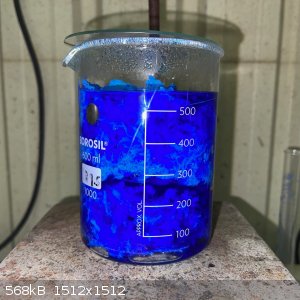
- I expected this stuff to be a sticky mess but it was not. It was more like wax. I scratched it out into a dish, I estimate the weight was more than
400g.
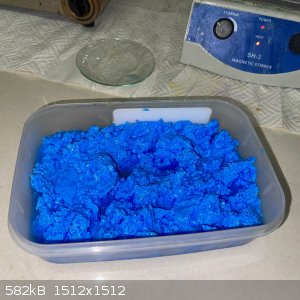
- I placed this dish in the sun for 3 hours but the weight drop was only 10g.
- I then tried to dry it on steam baths:
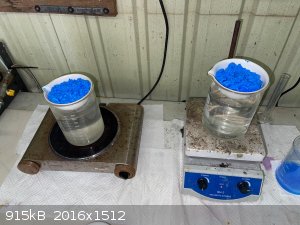
- The weight steadily decreased on the steam bath. Total drying time was some 12 hours before the weight loss rate was near zero.
- The dry remains were then crushed and bottled. It seemed dry and free flowing. I suspect that one of the batches had a slightly different moisture
content left as there are 2 different shades of blue in the bottle:
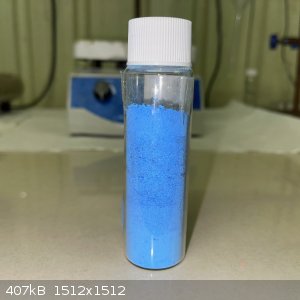
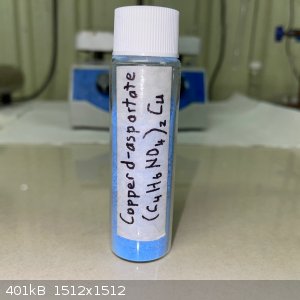
- The dry blue powder is only sparingly soluble in water but dissolves quickly in concentrated HCl.
- Total recovery was 18.7g; very close to the theoretical yield.
- Not shown on these photos, but there a few isolated crystals with a much darker blue color. I wonder if the slight excess of carbonate resulted in
the formation of a small amount of C4H5NO4Cu. I should really investigate thus further but I'm running low on copper carbonate.
I'll probably try chromium next - but starting from the carbonate. Which I first have to make. With nickel and cobalt also planned.
|
|
|
vano
National Hazard
   
Posts: 661
Registered: 22-3-2019
Location: Georgia
Member Is Offline
|
|
Nice work. Thanks for sharing.
|
|
|
Lion850
National Hazard
   
Posts: 514
Registered: 7-10-2019
Location: Australia
Member Is Offline
Mood: Great
|
|
Chromium & d-aspartic:
- 16.8g chromium (iii) nitrate nonahydrate dissolved in 40g water
- 8.8g potassium carbonate dissolved in 40g water and then slowly added to the Cr(NO3)3 solution while stirring.
- The idea of this step was to make chromium carbonate. A green-grey suspension formed, but there was also some bubbles so the final ppt could have
been a mix of chromium carbonate and hydroxide.
- Filter. Clear filtrate and green-grey remainder. Wash remainder twice in funnel with water.
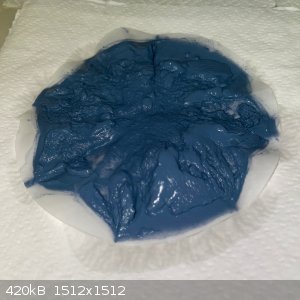
- Dissolve 16.6g D-aspartic acid in 500g water. At boil all dissolved and gave a clear solution.
- Start adding the wet green-grey remainder. Stir and keep at boil for some 24hrs spread out over a few days. During the first 18 hours of boiling the
solution went through colour changes as below, then the colour remained steady for the last few hours.
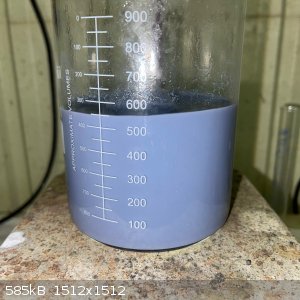 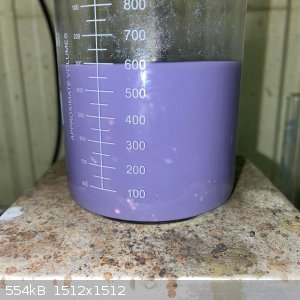 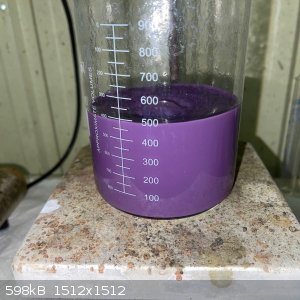
- Stop heat and stirring and let settle out. Below is the result.
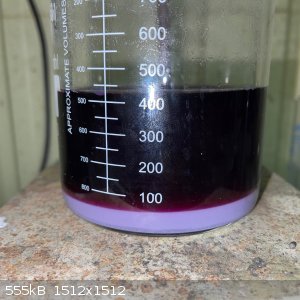
- Filter. Dried the green-grey remainder to check the weight: 4g.
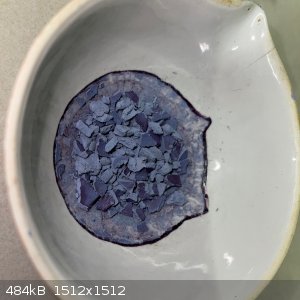
- Boil the dark maroon filtrate down to 50ml and then in an evaporating dish on the steam bath.
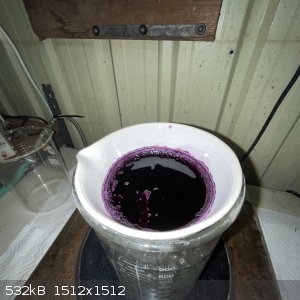
- On the steam bath for some 12 hours until weight loss stopped. Result was 20g of dry crystals with a "mauve" colour according to the colour chart.
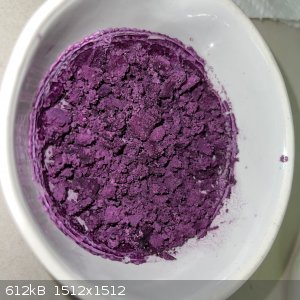 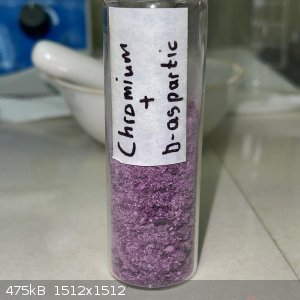
So, a very similar colour to what chromium gave with b-alanine, which I guess is to be expected.
|
|
|
vano
National Hazard
   
Posts: 661
Registered: 22-3-2019
Location: Georgia
Member Is Offline
|
|
Nice compound. It's looks like cobalt salt.
|
|
|
Lion850
National Hazard
   
Posts: 514
Registered: 7-10-2019
Location: Australia
Member Is Offline
Mood: Great
|
|
Nickel - first failed attempt
My first attempt at making a nickel - d-aspartic acid complex turned into a mess but resulted in a lovely deep blue compound.
I had some old lithium under oil that was going yucky and I managed to get 1 gram of clean lithium metal out of the mess. I thought to see if lithium
would assist to get aspartic acid to dissolved in water by forming the lithium salt (as sodium does). It did do something, because the 13g of aspartic
acid dissolved in less water once the gram of lithium was chucked in. I then wondered what colour this would give with nickel (sodium alanine salt and
nickel nitrate gave a blue ppt).
I added a green solution of nickel nitrate to the clear solution of aspartic acid + lithium but it just made a paler green solution, no ppt. I then
started adding sodium hydroxide in small portions in solid form.
Initially the sodium hydroxide reacted vigorously and the solution color shifted to blue, then dark purple. When I next added more NaOH a sea green
suspension formed. After this the added NaOH reacted much less vigorously when added which was interesting to observe, but did shift the colour back
towards blue.
I filtered the solution and was left with sea green remainder and dark blue filtrate:
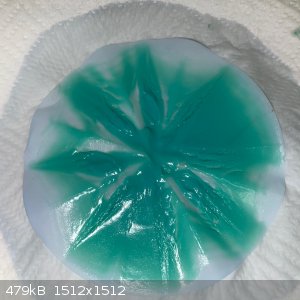
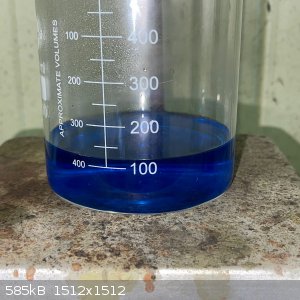
I left the remainder out on the filter paper to dry but it became so well stuck to the filter paper that I had to chuck it out. I boiled down the
filtrate to around 50ml, then on the steam bath for many hours. It formed a dark blue but very sticky and very hygroscopic thick syrup. And I could
not get a dry product. I tried stirring with boiling methanol, and boiling toluene, and more hours on the steam bath but to know avail. But I did
learn that this compound is not at all soluble in either methanol, toluene, or acetone. This was as far as I got after yet more hours on the steam
bath:
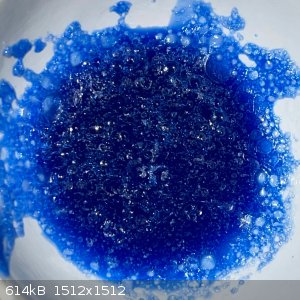
I ran out of time and ideas, so I dissolved the steam bath content in minimal water and bottled this to at least have a sample albeit in solution.
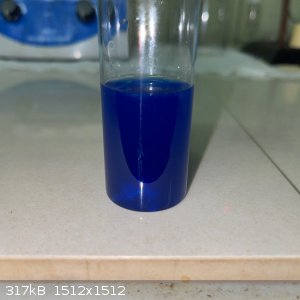
I'll try nickel again, but going the way of the sodium aspartic salt and then adding nickel nitrate to that (as I made the nickel-alanine blue salt)
(and without Lithium!).
|
|
|
Lion850
National Hazard
   
Posts: 514
Registered: 7-10-2019
Location: Australia
Member Is Offline
Mood: Great
|
|
Cobalt & d-aspartic:
- 13.2g aspartic acid added to 400g water in a beaker; at boil it all dissolved into a clear solution.
- 5g basic cobalt carbonate was added in small portions. The reaction was surprisingly vigorous:
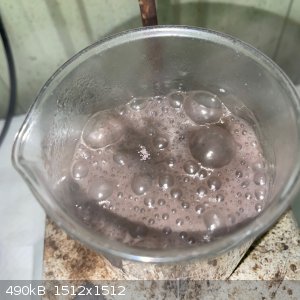
- After 2 hour stirring add 1g more basic cobalt carbonate - almost no reaction indicating most of the aspartic acid was consumed. Solution pH was
approximately 4.
- Stir for another 30 minutes.
- Gravity filter. Some unreacted dark brown remainder, plus a very dark byzantine (in the violet column of my color chart) filtrate.
- Filter a second time as some fine dark matter made it through the filter paper the first time.
- Steam down to around 50ml, then on steam bath for some 8 hours.
- Final product was rock hard in some places and still a tad sticky in others.
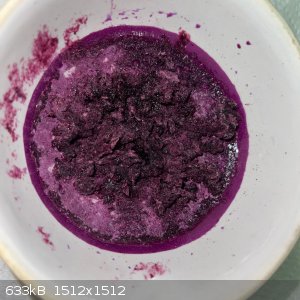 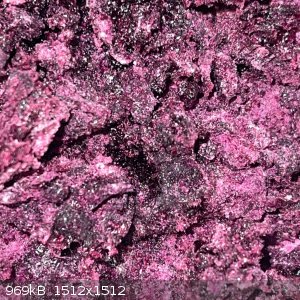
- 14g product bottled; some in very fine powder form that sticks to the sides of the bottle.
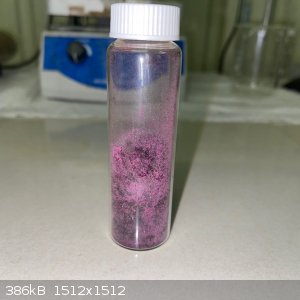
- Below a family photo of the alanine and aspartic salts made the last few weeks. From left to right:
Copper + b-alanine, copper + d-aspartic, nickel + b-alanine + sodium, nickel + d-aspartic + sodium + lithium (solution), chromium + b-alanine +
sodium, chromium + b-alanine, chromium + d-aspartic, cobalt + d-aspartic, erbium + b-alanine + sodium.
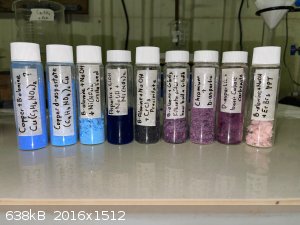
|
|
|
vano
National Hazard
   
Posts: 661
Registered: 22-3-2019
Location: Georgia
Member Is Offline
|
|
Nice. You have really good collection.
|
|
|
Bezaleel
Hazard to Others
  
Posts: 444
Registered: 28-2-2009
Member Is Offline
Mood: transitional
|
|
Nice work, Lion850! If you'd like to add some more brothers and sisters to your family, consider cyanuric acid. This can be obtained cheaply from pool
chlorinator and has a very interesting chemistry with the d-block metals. There is a famous review article by Seifer et al (by heart) which shows that
copper alone has at least 6 different cyanurates.
|
|
|
Lion850
National Hazard
   
Posts: 514
Registered: 7-10-2019
Location: Australia
Member Is Offline
Mood: Great
|
|
Hi Bezaleel some time ago I did make cyanuric salts:
https://www.sciencemadness.org/whisper/viewthread.php?tid=15...
This one is one of my favourites: a deep pure purple obtained reacting copper powder in a cyanuric acid solution for near 100 hours:
https://www.sciencemadness.org/whisper/viewthread.php?tid=15...
|
|
|
Bezaleel
Hazard to Others
  
Posts: 444
Registered: 28-2-2009
Member Is Offline
Mood: transitional
|
|
It's interesting you took the time to react copper metal with the weak cyanuric acid and that you did actually get a result. I don't think many people
have made that compound, contrary to the sodium copper cyanurates and sodium copper chlorocyanurates.
I once tried using copper hydroxide, but it didn't happily react either. When I heated the solution to speed things up, the copper hydroxide turned
into black copper oxide. Maybe I should retry it, to see whether the purple copper cyanurate can be made from the hydroxide also, or whether it only
forms the basic form that Seifer also mentions (as you said).
|
|
|